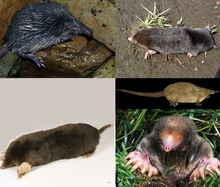

Moles are small mammals adapted to a subterranean lifestyle. They have cylindrical bodies, velvety fur, very small, inconspicuous eyes and ears,[1] reduced hindlimbs, and short, powerful forelimbs with large paws adapted for digging.
The word "mole" most commonly refers to many species in the family Talpidae (which are named after the Latin word for mole, talpa).[2] True moles are found in most parts of North America, Europe and Asia.[3] Other mammals referred to as moles include the African golden moles and the Australian marsupial moles, which have a similar ecology and lifestyle to true moles, but are unrelated.
Moles may be viewed as pests to gardeners, but they provide positive contributions to soil, gardens, and ecosystems, including soil aeration, feeding on slugs and small creatures that eat plant roots, and providing prey for other wildlife. They eat earthworms and other small invertebrates in the soil.[4][5]
- ^ Kott, Ondřej; Sumbera, Radim; Nemec, Pavel (2010). Iwaniuirst, Andrew (ed.). "Light Perception in Two Strictly Subterranean Rodents: Life in the Dark or Blue?". PLOS ONE. 5 (7): e11810. Bibcode:2010PLoSO...511810K. doi:10.1371/journal.pone.0011810. PMC 2911378. PMID 20676369.
- ^ Riddle, Joseph Edmond (1838). A Complete English-Latin Dictionary, for the Use of Colleges and Schools. London: Longman, Orme, Brown, Green and Longmans, Paternoster-Row; and John Murray, Albemarle Street. p. 193.
- ^ Campbell, Kevin. "Mole Distribution Maps". University of Manitoba. Archived from the original on 24 March 2010. Retrieved 11 March 2010.
- ^ Arlton, A.V. (1936). "An Ecological Study of the Mole". Journal of Mammalogy. 17 (4): 349–371. doi:10.2307/1374401. JSTOR 1374401.
- ^ Streitberger, Merle (2016). Ants and Moles as Ecosystem Engineers: The Role of Small-scale Disturbance for Biodiversity in Central European Grasslands. Osnabrück.
{{cite book}}: CS1 maint: location missing publisher (link)